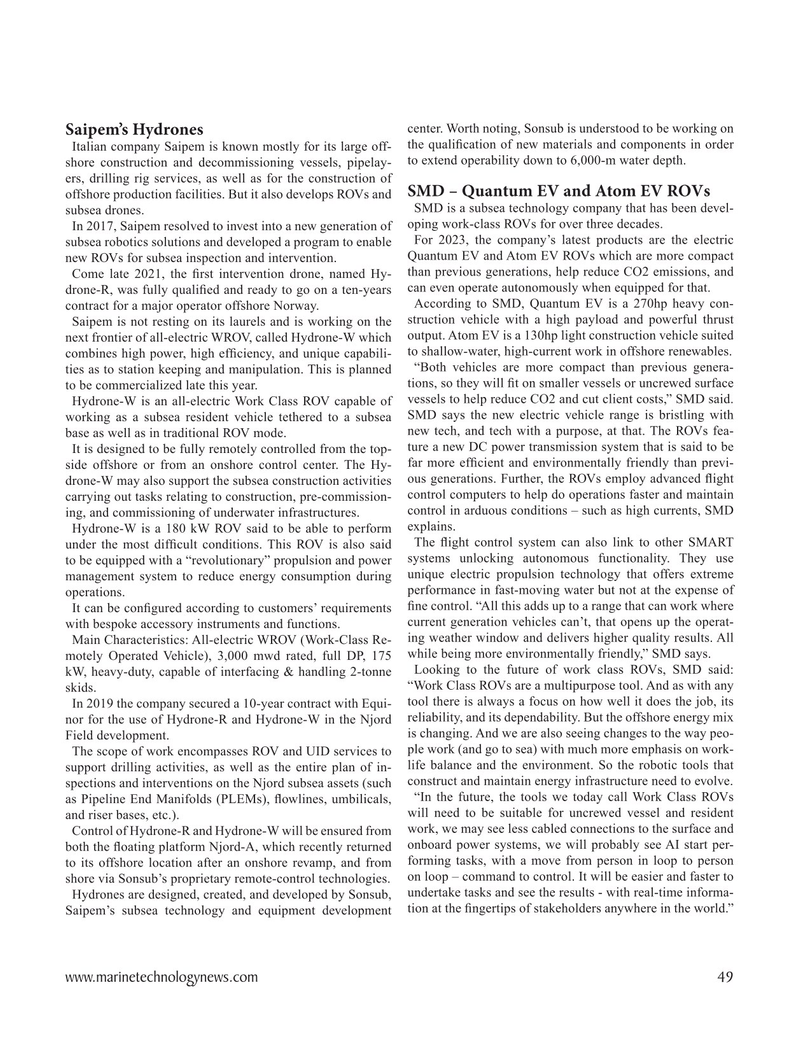
Page 49: of Marine Technology Magazine (March 2023)
Read this page in Pdf, Flash or Html5 edition of March 2023 Marine Technology Magazine
center. Worth noting, Sonsub is understood to be working on
Saipem’s Hydrones the quali? cation of new materials and components in order
Italian company Saipem is known mostly for its large off- to extend operability down to 6,000-m water depth.
shore construction and decommissioning vessels, pipelay- ers, drilling rig services, as well as for the construction of
SMD – Quantum EV and Atom EV ROVs offshore production facilities. But it also develops ROVs and
SMD is a subsea technology company that has been devel- subsea drones.
In 2017, Saipem resolved to invest into a new generation of oping work-class ROVs for over three decades.
For 2023, the company’s latest products are the electric subsea robotics solutions and developed a program to enable
Quantum EV and Atom EV ROVs which are more compact new ROVs for subsea inspection and intervention.
than previous generations, help reduce CO2 emissions, and
Come late 2021, the ? rst intervention drone, named Hy- drone-R, was fully quali? ed and ready to go on a ten-years can even operate autonomously when equipped for that.
According to SMD, Quantum EV is a 270hp heavy con- contract for a major operator offshore Norway.
Saipem is not resting on its laurels and is working on the struction vehicle with a high payload and powerful thrust next frontier of all-electric WROV, called Hydrone-W which output. Atom EV is a 130hp light construction vehicle suited to shallow-water, high-current work in offshore renewables.
combines high power, high ef? ciency, and unique capabili- “Both vehicles are more compact than previous genera- ties as to station keeping and manipulation. This is planned tions, so they will ? t on smaller vessels or uncrewed surface to be commercialized late this year.
Hydrone-W is an all-electric Work Class ROV capable of vessels to help reduce CO2 and cut client costs,” SMD said. working as a subsea resident vehicle tethered to a subsea SMD says the new electric vehicle range is bristling with new tech, and tech with a purpose, at that. The ROVs fea- base as well as in traditional ROV mode.
ture a new DC power transmission system that is said to be
It is designed to be fully remotely controlled from the top- far more ef? cient and environmentally friendly than previ- side offshore or from an onshore control center. The Hy- drone-W may also support the subsea construction activities ous generations. Further, the ROVs employ advanced ? ight control computers to help do operations faster and maintain carrying out tasks relating to construction, pre-commission- control in arduous conditions – such as high currents, SMD ing, and commissioning of underwater infrastructures.
Hydrone-W is a 180 kW ROV said to be able to perform explains.
The ? ight control system can also link to other SMART under the most dif? cult conditions. This ROV is also said to be equipped with a “revolutionary” propulsion and power systems unlocking autonomous functionality. They use management system to reduce energy consumption during unique electric propulsion technology that offers extreme performance in fast-moving water but not at the expense of operations.
It can be con? gured according to customers’ requirements ? ne control. “All this adds up to a range that can work where current generation vehicles can’t, that opens up the operat- with bespoke accessory instruments and functions.
ing weather window and delivers higher quality results. All
Main Characteristics: All-electric WROV (Work-Class Re- motely Operated Vehicle), 3,000 mwd rated, full DP, 175 while being more environmentally friendly,” SMD says.
Looking to the future of work class ROVs, SMD said: kW, heavy-duty, capable of interfacing & handling 2-tonne “Work Class ROVs are a multipurpose tool. And as with any skids.
tool there is always a focus on how well it does the job, its
In 2019 the company secured a 10-year contract with Equi- nor for the use of Hydrone-R and Hydrone-W in the Njord reliability, and its dependability. But the offshore energy mix is changing. And we are also seeing changes to the way peo-
Field development.
The scope of work encompasses ROV and UID services to ple work (and go to sea) with much more emphasis on work- life balance and the environment. So the robotic tools that support drilling activities, as well as the entire plan of in- spections and interventions on the Njord subsea assets (such construct and maintain energy infrastructure need to evolve.
“In the future, the tools we today call Work Class ROVs as Pipeline End Manifolds (PLEMs), ? owlines, umbilicals, will need to be suitable for uncrewed vessel and resident and riser bases, etc.).
work, we may see less cabled connections to the surface and
Control of Hydrone-R and Hydrone-W will be ensured from both the ? oating platform Njord-A, which recently returned onboard power systems, we will probably see AI start per- to its offshore location after an onshore revamp, and from forming tasks, with a move from person in loop to person on loop – command to control. It will be easier and faster to shore via Sonsub’s proprietary remote-control technologies.
Hydrones are designed, created, and developed by Sonsub, undertake tasks and see the results - with real-time informa-
Saipem’s subsea technology and equipment development tion at the ? ngertips of stakeholders anywhere in the world.” www.marinetechnologynews.com 49
MTR #3 (34-49).indd 49 3/19/2023 7:58:31 PM

 48
48

 50
50
